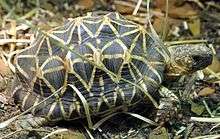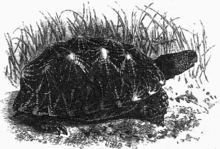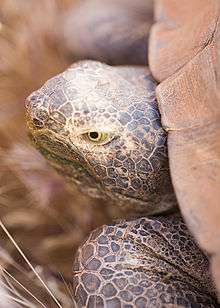Indian star tortoise
| Indian star tortoise | |
|---|---|
 | |
| Tortoise at the Houston Zoo | |
| Scientific classification | |
| Kingdom: | Animalia |
| Phylum: | Chordata |
| Class: | Sauropsida |
| Order: | Testudines |
| Suborder: | Cryptodira |
| Superfamily: | Testudinoidea |
| Family: | Testudinidae |
| Genus: | Geochelone |
| Species: | G. elegans |
| Binomial name | |
| Geochelone elegans Schoepf, 1795 | |
| Synonyms[1] | |
| |

The Indian star tortoise (Geochelone elegans) is a species of tortoise found in dry areas and scrub forest in India and Sri Lanka. This species is quite popular in the exotic pet trade.
Anatomy and morphology
The carapace of G. elegans is very convex, with dorsal shields often forming humps; the lateral margins are nearly vertical; the posterior margin is somewhat expanded and strongly serrated. It has no nuchal scute, and the supracaudal is undivided, and curved inward in the male; the shields are strongly striated concentrically. The first vertebral scute is longer than broad, and the others are broader than long, with the third at least as broad as the corresponding costal. The plastron is large, truncated or openly notched in front, and deeply notched and bifid behind; the suture between the humerals is much longer than that between the femorals; the suture between the pectorals is very short; the axillary and inguinal sutures are rather small. The head is moderate in size, with the forehead swollen, convex, and covered with rather small and irregular shields; the beak is feebly hooked, bi- or tricuspid; the edges of the jaws are denticulated; the alveolar ridge of the upper jaw is strong. The outer-anterior face of the fore limbs have numerous unequal-sized, large, imbricate, bony, pointed tubercles; the heel has large, more or less spur-like tubercles; a group of large conical or subconical tubercles is found on the hinder side of the thigh. The carapace is black, with yellow areolae from which yellow streaks radiate; these streaks are usually narrow and very numerous. The plastron likewise has black and yellow, radiating streaks. The Indian star tortoise can grow to 10 inches long. [2]
The patterning, although highly contrasting, is disruptive and breaks the outline of the tortoise as it sits in the shade of grass or vegetation. They are mostly herbivorous and feed on grasses, fallen fruit, flowers, and leaves of succulent plants, and will occasionally eat carrion. In captivity, however, they should never be fed meat.
The sexual dimorphism of adult Indian star tortoises is quite apparent. Females are considerably larger than their male counterparts. In addition, the females' plastrons are much flatter than those of the males, which have a concave shape.
The shape of this creature is presumed to be specially adapted to naturally assist it to return to a stable stance after it has been turned over. Mathematicians Gábor Domokos of the Budapest University of Technology and Economics and Péter Várkonyi of Princeton University designed a homogeneous object called a gömböc that has exactly one unstable balance point and exactly one stable balance point. Just as a bottom-weighted (nonhomogeneous weight distribution) sphere would always return to the same upright position, they found it was possible to construct a shape that behaves the same way. After that, they noted the similarity to the Indian star tortoise and subsequently tested 30 turtles by turning them upside down. They found many of them to be self-righting.[3][4]
Range and distribution
They range from India (except Lower Bengal), extending west to Sindh province (Pakistan), and Sri Lanka.
Pet market
_at_IGZoo_park_Visakhapatnam.jpg)

A large number of specimens of this species are found in the illegal wildlife trade in India. Few studies exist which have quantified wild populations and the effect of trade on them.[5]
References
- ↑ Fritz Uwe; Peter Havaš (2007). "Checklist of Chelonians of the World". Vertebrate Zoology. 57 (2): 279. ISSN 1864-5755. Archived from the original (PDF) on 2010-12-17. Retrieved 29 May 2012.
- ↑ Boulenger, G.A.(1890) Fauna of British India. Reptilia and Batrachia.
- ↑ CBC Quirks and Quarks 2007-10-27: "Turning Turtles". Interview with Dr. Gabor Domokos.
- ↑ Varkonyi, P.L., Domokos, G.: Mono-monostatic bodies: the answer to Arnold's question. The Mathematical Intelligencer, 28 (4) pp 34–38.(2006.)
- ↑ http://www.thehindu.com/todays-paper/tp-opinion/uncovering-the-tortoise-trade-route/article1850672.ece
Bibliography
- Asian Turtle Trade Working Group (2000). "Geochelone elegans". IUCN Red List of Threatened Species. Version 2006. International Union for Conservation of Nature. Retrieved 12 May 2006.
External links
| Wikimedia Commons has media related to Indian star tortoise. |

